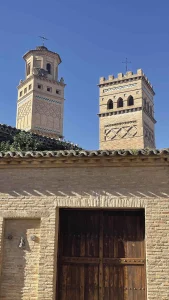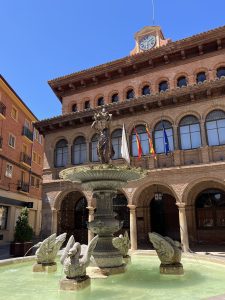

Didactic Mudejar, the guide

Projects

"Fiel Villa" of Muel
We can place the origin of the town of Muel around the 1st century, in Roman times. Its importance lies in the creation of a Roman dam, built with the intention of regulating the water supply from the river Huerva to the most important city of the time: Caesaraugusta.
The castle of the Marquises of Camarasa, located on the highest point of the town, is identified with a castle of Islamic origin, which could also give its name to the village , mentioned as “Muwala”.
Later, there is medieval documentation, specifically from the year 1160, in which the name Molle appears. It has been linked to the word “muelle”, understanding this reference to the dam of Roman origin, as well as to “muela”, referring to the millstone.
In the year 1495, in Muel, 99 fires were recorded, which means that the town was inhabited by some 400 inhabitants, most of them Moors, Mudejars who had been forcibly converted to Christianity.
The Islamic tradition
The Islamic tradition, the result of so many centuries of cultural coexistence, is reflected in the importance of the town’s pottery workshops, important examples of which have survived.
After the expulsion of the Moors from Aragon in 1610, the town was practically depopulated. However, this work was perpetuated among the new settlers during the 17th, 18th and 19th centuries, turning Muel into a leading craft and export centre.
Although it was one of the most reputable centres, this work was interrupted in 1920 due to the introduction of new materials. It was not until 1965 that pottery work was resumed again with new professionals.
The vestiges of the medieval past in the town of Muel can be seen in different key points. One of them, the tower of the church of San Cristóbal, is the only Mudejar architectural element in the church. The current building corresponds to a work from the Baroque period.
Walking through its streets we can quickly appreciate the urban framework of Islamic tradition, with narrow, dead-end streets. In addition, the Puerta de la Villa or Mudejar Arch in the Calle Mayor still stands.
It is worth stopping along the way at the Parque de la Fuente, where, surrounded by an impressive natural setting, stands the Roman dam, which serves as the foundations of the hermitage of Nuestra Señora de la Fuente, an 18th century construction that houses wall paintings attributed to Fracisco de Goya.
Territorio Mudéjar Network
The city council has been a founding partner of Territorio Mudéjar since 2023.
More information
Town Hall: 976 140 001
muel.es
DO YOU WANT TO KNOW MORE?
Tourism Calatayud Region
turismodearagon.com
Tourism Campo de Cariñena Region
campodecarinena.es
Projects Territorio Mudéjar in Muel
Monumentos | Ver el proyecto
Pedagogía | Ver el proyecto
Proyecto Mudetrad | Ver el proyecto
Mudéjar didáctico, la guía | Ver el proyecto
“Circular” Paseos en familia | Ver el proyecto










